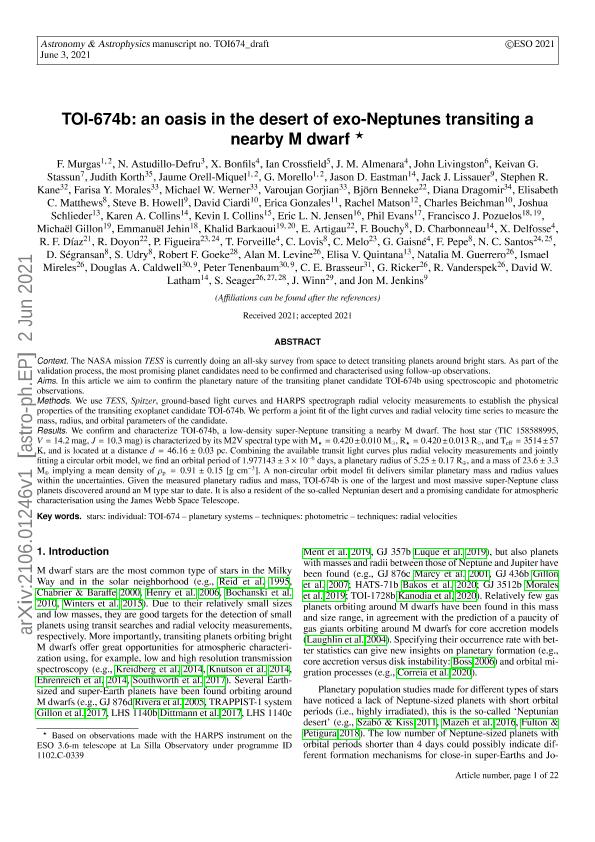Artículo
TOI-674b: An oasis in the desert of exo-Neptunes transiting a nearby M dwarf
Murgas, F.; Astudillo Defru, Nicola; Bonfils, X.; Crossfield, I.; Almenara, J. M.; Livingston, John; Stassun, Keivan G.; Korth, Judith; Orell Miquel, Jaume; Morello, G.; Eastman, J. D.; Lissauer, J. J.; Kane, S. R.; Morales, F. Y.; Werner, M. W.; Gorjian, V.; Benneke, B.; Dragomir, D.; Matthews, E. C.; Howell, S. B.; Ciardi, D.; Gonzales, E.; Matson, R.; Beichman, C.; Schlieder, J.; Collins, K. A.; Collins, K. I.; Jensen, E. L. N.; Evans, P.; Pozuelos, F. J.; Gillon, M.; Jehin, E.; Barkaoui, K.; Artigau, E.; Bouchy, F.; Charbonneau, D.; Delfosse, X.; Díaz, Rodrigo Fernando ; Doyon, R.; Figueira, P.; Forveille, T.; Lovis, C.; Melo, C.; Gaisné, G.; Pepe, F.; Santos, N. C.; Ségransan, D.; Udry, S.; Goeke, R. F.; Levine, A. M.; Quintana, E. V.; Guerrero, N. M.; Mireles, I.; Caldwell, D. A.; Tenenbaum, P.; Brasseur, C. E.; Ricker, G.; Vanderspek, R.; Latham, D. W.; Seager, S.; Winn, J.; Jenkins, J. M.
; Doyon, R.; Figueira, P.; Forveille, T.; Lovis, C.; Melo, C.; Gaisné, G.; Pepe, F.; Santos, N. C.; Ségransan, D.; Udry, S.; Goeke, R. F.; Levine, A. M.; Quintana, E. V.; Guerrero, N. M.; Mireles, I.; Caldwell, D. A.; Tenenbaum, P.; Brasseur, C. E.; Ricker, G.; Vanderspek, R.; Latham, D. W.; Seager, S.; Winn, J.; Jenkins, J. M.
 ; Doyon, R.; Figueira, P.; Forveille, T.; Lovis, C.; Melo, C.; Gaisné, G.; Pepe, F.; Santos, N. C.; Ségransan, D.; Udry, S.; Goeke, R. F.; Levine, A. M.; Quintana, E. V.; Guerrero, N. M.; Mireles, I.; Caldwell, D. A.; Tenenbaum, P.; Brasseur, C. E.; Ricker, G.; Vanderspek, R.; Latham, D. W.; Seager, S.; Winn, J.; Jenkins, J. M.
; Doyon, R.; Figueira, P.; Forveille, T.; Lovis, C.; Melo, C.; Gaisné, G.; Pepe, F.; Santos, N. C.; Ségransan, D.; Udry, S.; Goeke, R. F.; Levine, A. M.; Quintana, E. V.; Guerrero, N. M.; Mireles, I.; Caldwell, D. A.; Tenenbaum, P.; Brasseur, C. E.; Ricker, G.; Vanderspek, R.; Latham, D. W.; Seager, S.; Winn, J.; Jenkins, J. M.
Fecha de publicación:
09/2021
Editorial:
EDP Sciences
Revista:
Astronomy and Astrophysics
ISSN:
0004-6361
Idioma:
Inglés
Tipo de recurso:
Artículo publicado
Clasificación temática:
Resumen
Context. The NASA mission TESS is currently doing an all-sky survey from space to detect transiting planets around bright stars. As part of the validation process, the most promising planet candidates need to be confirmed and characterized using follow-up observations. Aims. In this article, our aim is to confirm the planetary nature of the transiting planet candidate TOI-674b using spectroscopic and photometric observations. Methods. We use TESS, Spitzer, ground-based light curves, and HARPS spectrograph radial velocity measurements to establish the physical properties of the transiting exoplanet candidate TOI-674b. We perform a joint fit of the light curves and radial velocity time series to measure the mass, radius, and orbital parameters of the candidate. Results. We confirm and characterize TOI-674b, a low-density super-Neptune transiting a nearby M dwarf. The host star (TIC 158588995, V = 14.2 mag, J = 10.3 mag) is characterized by its M2V spectral type with M = 0.420 ± 0.010 M , R = 0.420 ± 0.013 R , and Teff = 3514 ± 57 K; it is located at a distance d = 46.16 ± 0.03 pc. Combining the available transit light curves plus radial velocity measurements and jointly fitting a circular orbit model, we find an orbital period of 1.977143 ± 3 × 10-6 days, a planetary radius of 5.25 ± 0.17 R , and a mass of 23.6 ± 3.3 M implying a mean density of ρp =0.91 ± 0.15 g cm-3. A non-circular orbit model fit delivers similar planetary mass and radius values within the uncertainties. Given the measured planetary radius and mass, TOI-674b is one of the largest and most massive super-Neptune class planets discovered around an M-type star to date. It is found in the Neptunian desert, and is a promising candidate for atmospheric characterization using the James Webb Space Telescope.
Archivos asociados
Licencia
Identificadores
Colecciones
Articulos (ICIFI)
Articulos de INSTITUTO DE CIENCIAS FISICAS
Articulos de INSTITUTO DE CIENCIAS FISICAS
Citación
Murgas, F.; Astudillo Defru, Nicola; Bonfils, X.; Crossfield, I.; Almenara, J. M.; et al.; TOI-674b: An oasis in the desert of exo-Neptunes transiting a nearby M dwarf; EDP Sciences; Astronomy and Astrophysics; 653; 9-2021; 1-22
Compartir
Altmétricas



